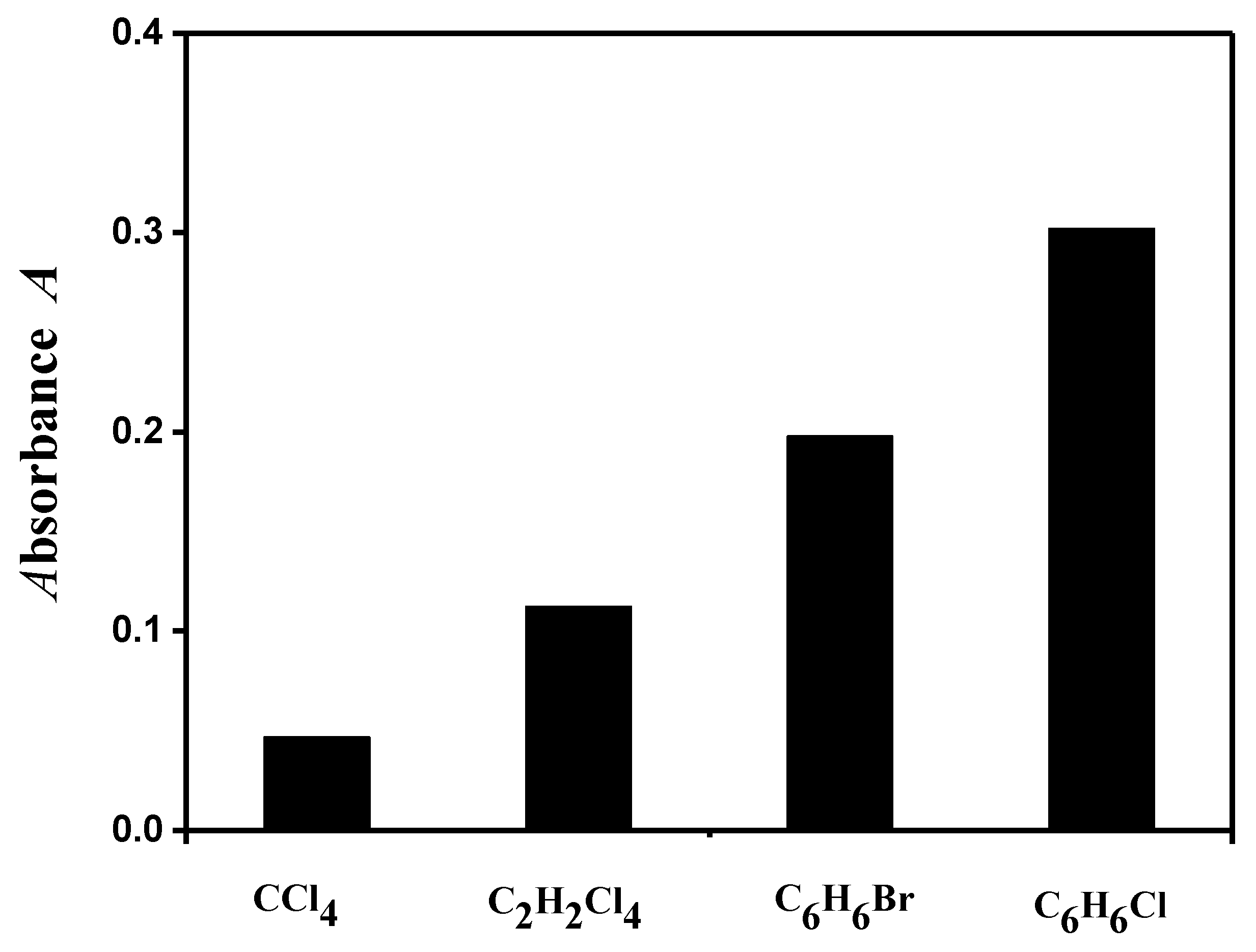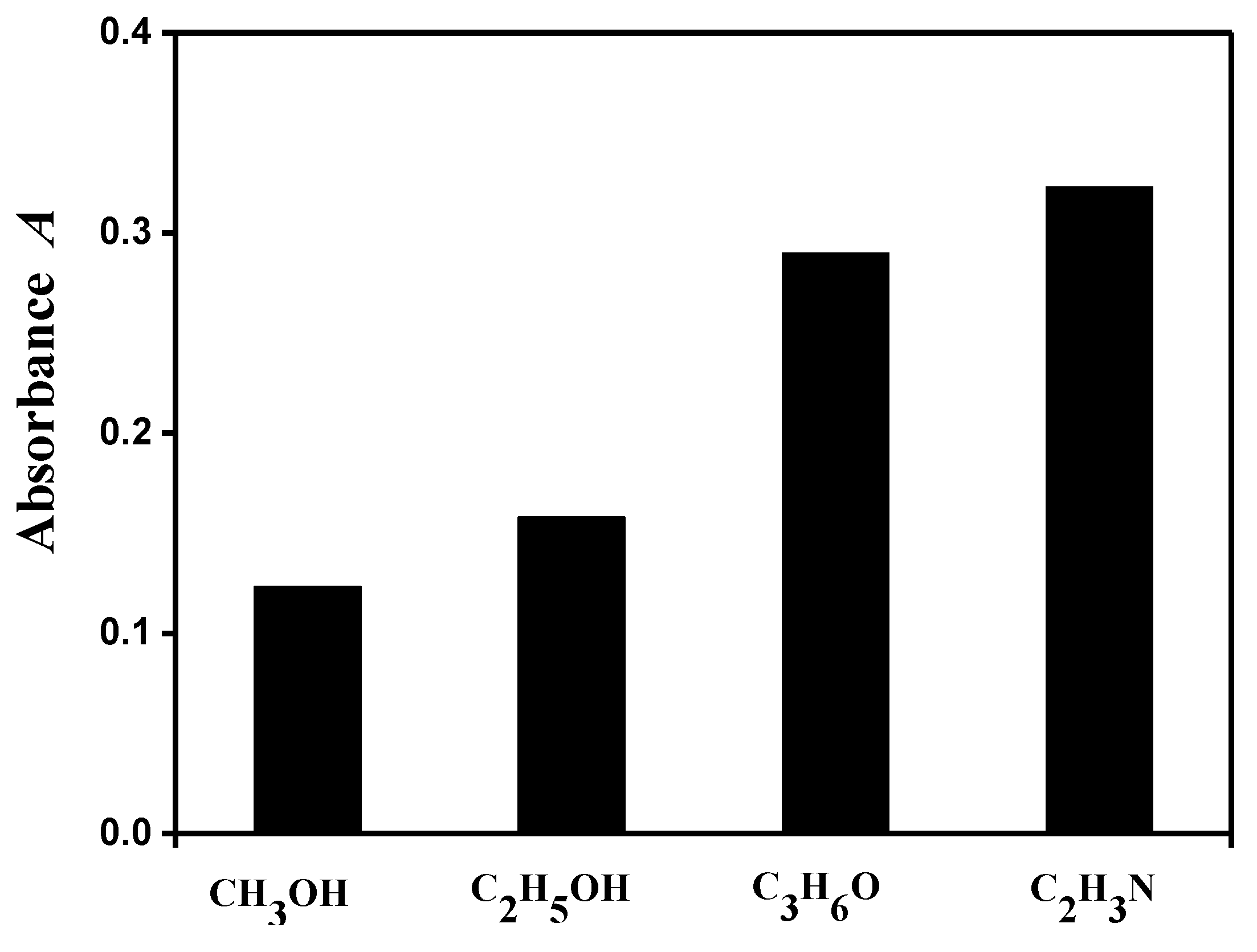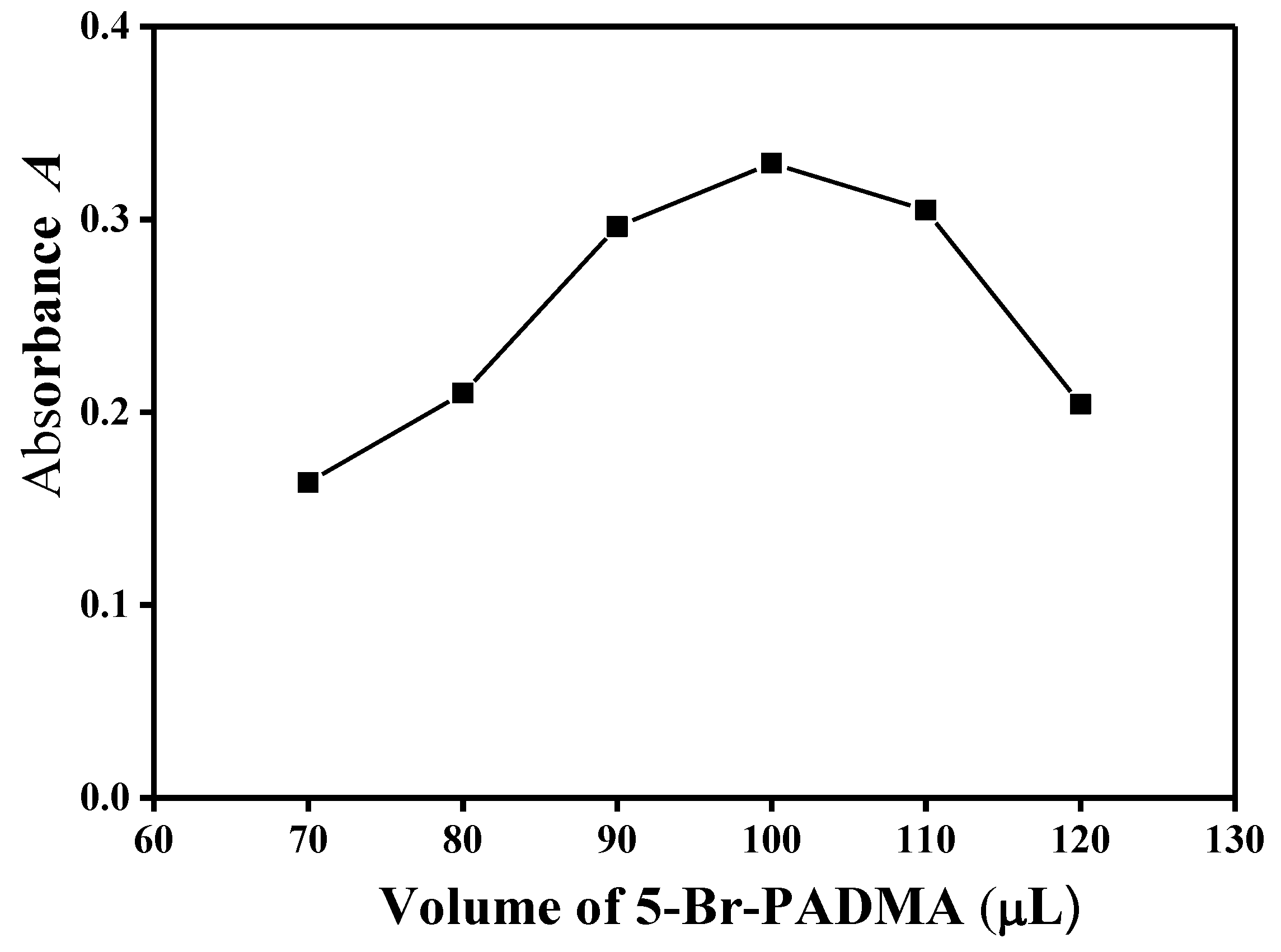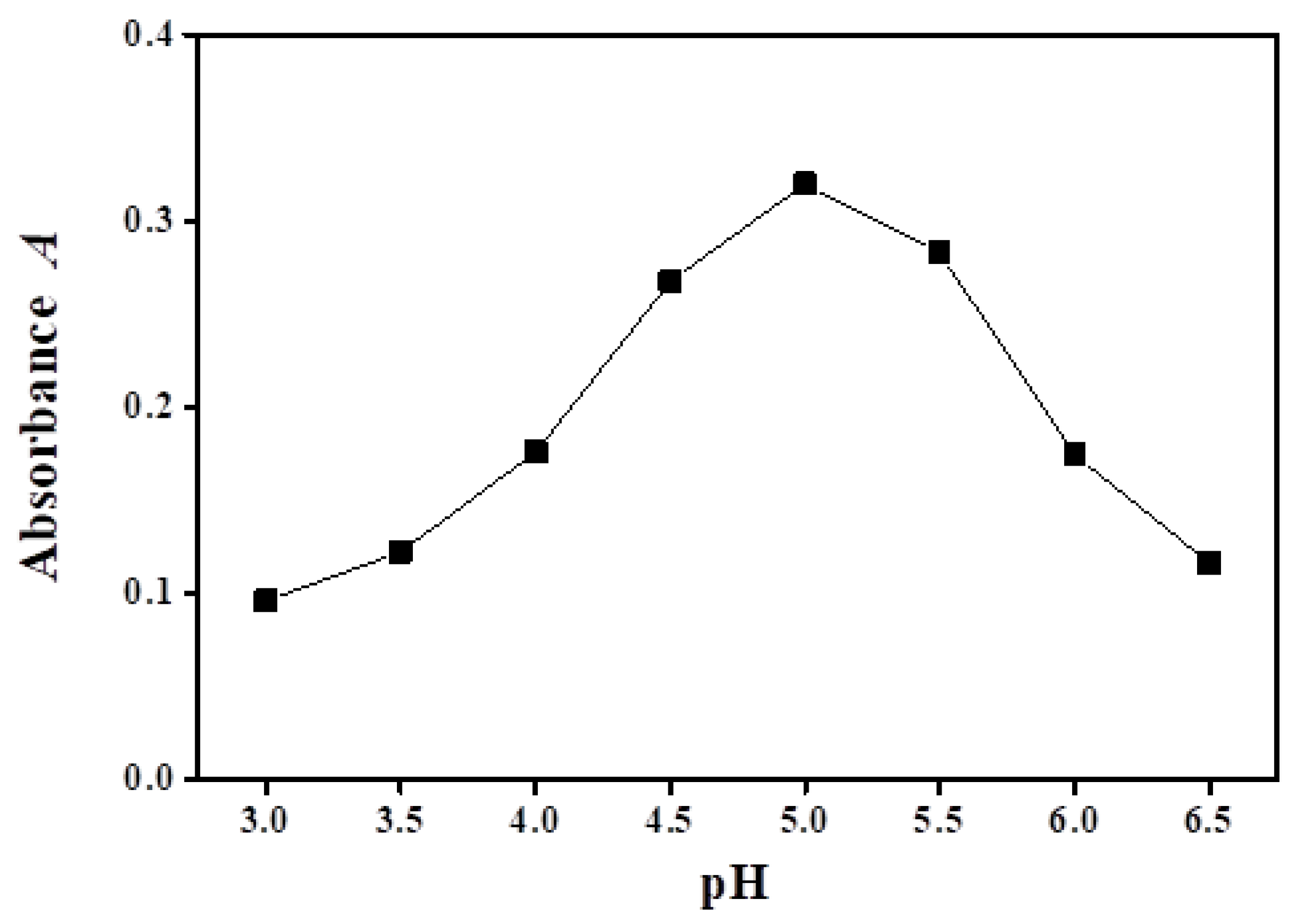Determination of Ultra-Trace Amounts of Copper in Environmental Water Samples by Dispersive Liquid-Liquid Microextraction Combined with Graphite Furnace Atomic Absorption Spectrometry
Abstract
:1. Introduction
2. Experimental Section
2.1. Apparatus
2.2. Reagents and Solutions
2.3. Dispersive Liquid-Liquid Microextraction Procedure
2.4. Preparation of Real Samples
3. Results and Discussion
3.1. Type and Volume of Extractor Solvent
3.2. Effect of Disperser Solvent and Its Volume
3.3. Effect of the Amount of the Chelating Agent 5-Br-PADAM
3.4. Influence of pH of Test Solution
3.5. The Influence of Extraction and Centrifugation Time
3.6. Effects of Interfering Ions
3.7. Analytical Figures of Merit
3.8. Analysis of Real Samples
4. Conclusions
Author Contributions
Funding
Data Availability Statement
Conflicts of Interest
References
- Lee, I.; Ko, J.; Park, S.; Lim, J.; Shin, I.; Moon, C.; Kim, S.; Her, J.; Kim, J. Comparative toxicity and biodistribution of copper nanoparticles and cupric ions in rats. Int. J. Nanomed. 2016, 11, 2883–2900. [Google Scholar]
- Kucharzewski, M.; Braziewicz, J.; Majewska, U.; Gozdz, S. Copper, zinc, and selenium in whole blood and thyroid tissue of people with various thyroid diseases. Biol. Trace Elem. Res. 2003, 93, 9–18. [Google Scholar] [CrossRef] [PubMed]
- Mendil, D.; Uluozlu, O.D.; Tüzen, M.; Soylak, M. Investigation of the levels of some element in edible oil samples produced in Turkey by atomic absorption spectrometry. J. Hazard. Mater. 2009, 165, 724–728. [Google Scholar] [CrossRef] [PubMed]
- Theophanides, T.; Anastassopoulou, J. Copper and carcinogenesis. Crit. Rev. Oncol. Hematol. 2002, 42, 57–64. [Google Scholar] [CrossRef] [PubMed]
- Saeedi, Z.; Lotfi, A.; Hassanzadeh, J.; Bagheri, N. Highly sensitive determination of copper (II) ions using fluorescence and chemiluminescence emissions of modified CdS quantum dots after it’s preconcentration by dispersive liquid-liquid microextraction. Can. J. Chem. 2017, 95, 704–709. [Google Scholar] [CrossRef]
- Vojoudi, H.; Bastan, B.; Ghasemi, J.B.; Badiei, A. An ultrasensitive fluorescence sensor for determination of trace levels of copper in blood samples. Anal. Bioanal. Chem. 2019, 411, 5593–5603. [Google Scholar] [CrossRef]
- Alpdoğan, G.; Zor, Ş.D. A New dispersive liquid-liquid microextraction method for preconcentration and determination of aluminum, iron, copper, and lead in real water samples by HPLC. J. AOAC Int. 2017, 100, 1524–1530. [Google Scholar] [CrossRef]
- Silva, L.P.; Campos, N.D.S.; Lisboa, T.P.; de Faria, L.V.; Matos, M.A.C.; Matos, R.C.; de Sousa, R.A. Simultaneous determination of cadmium, lead and copper in chocolate samples by square wave anodic stripping voltammetry. Food Add. Contam. 2021, 38, 418–426. [Google Scholar] [CrossRef]
- Zaytsev, N.; Stancheva, K.; Trifonova, V. Application of Anodic Stripping Voltammetry at a Mercury Film Electrode for Simultaneous Determination of Zinc, Cadmium, Lead and Copper in Water and Soil Samples. Oxid. Commun. 2020, 43, 452–462. [Google Scholar]
- Sorouraddin, S.M.; Ali Farajzadeh, M.; Ghorbani, M. In situ-produced CO2-assisted dispersive liquid-liquid microextraction for extraction and preconcentration of cobalt, nickel, and copper ions from aqueous samples followed by graphite furnace atomic absorption spectrometry determination. J. Iran. Chem. Soc. 2018, 15, 201–209. [Google Scholar] [CrossRef]
- Sorouraddin, S.M. Simultaneous separation and preconcentration of ultra-trace of Cu(II), Pb(II) and Zn(II) in water samples by air-assisted liquid–liquid microextraction prior to determination by graphite furnace atomic absorption spectrometry. J. Iran. Chem. Soc. 2016, 13, 2219–2227. [Google Scholar] [CrossRef]
- Hayyat-Sarkar, Z.; Hashemi, S.H.; Jamali Keikha, A.; Kaykhaii, M. Application of polyethylene glycol-coated iron oxide nanoparticles for magnetic solid phase extraction of copper from seawater samples and its determination by graphite furnace atomic absorption spectrometry using response surface methodology for optimization of extraction. Spectrosc. Lett. 2021, 54, 254–265. [Google Scholar]
- Leila, R.; Yadollah, Y.; Abolfazl, S. Ionic liquid based dispersive liquid-liquid microextraction combined with ICP-OES for the determination of trace quantities of cobalt, copper, manganese, nickel and zinc in environmental water samples. Microchim. Acta 2012, 177, 119–127. [Google Scholar]
- Shoaee, H.; Roshdi, M.; Khanlarzadeh, N.; Beiraghi, A. Simultaneous preconcentration of copper and mercury in water samples by cloud point extraction and their determination by inductively coupled plasma atomic emission spectrometry. Spectrochim. Acta 2012, 98, 70–75. [Google Scholar] [CrossRef]
- Erdemir, U.S.; Sahan, Y.; Gucer, S. Fractionation and bioaccessibility of manganese, copper, zinc, cadmium, and lead in commercial vegetable and rice baby foods using inductively coupled plasma—Mass spectrometry (ICP-MS) with central composite design (CCD). Anal. Lett. 2019, 52, 2840–2851. [Google Scholar] [CrossRef]
- Wysocka, I.; Vassileva, E. Determination of cadmium, copper, mercury, lead and zinc mass fractions in marine sediment by isotope dilution inductively coupled plasma mass spectrometry applied as a reference method. Microchem. J. 2016, 128, 198–207. [Google Scholar] [CrossRef]
- Reza Jamali, M.; Assadi, Y.; Shemirani, F. Homogeneous liquid–liquid extraction and determination of cobalt, copper, and nickel in water samples by flame atomic absorption spectrometry. Sep. Sci. Technol. 2017, 42, 3503–3515. [Google Scholar] [CrossRef]
- Divarova, V.V.; Stojnova, K.T.; Racheva, P.V.; Lekova, V.D.; Dimitrov, A.N. Liquid–liquid extraction of ion-association complexes of cobalt(II)–4-(2-pyridylazo) resorcinol with ditetrazolium salts. J. Serb. Chem. Soc. 2015, 80, 179–186. [Google Scholar] [CrossRef]
- Wang, L.; Zhou, J.B.; Wang, X.; Wang, Z.H.; Zhao, R.S. Simultaneous determination of copper, cobalt, and mercury ions in water samples by solid-phase extraction using carbon nanotube sponges as adsorbent after chelating with sodium diethyldithiocarbamate prior to high performance liquid chromatography. Anal. Bioanal. Chem. 2016, 408, 4445–4453. [Google Scholar] [CrossRef]
- Shegefti, S.; Mehdinia, A.; Shemirani, F. Preconcentration of cobalt(II) using polythionine-coated Fe3O4 nanocomposite prior its determination by AAS. Microchim. Acta 2016, 183, 1963–1970. [Google Scholar] [CrossRef]
- Han, Q.; Huo, Y.Y.; Yang, N.; Yang, X.H.; Hao, T.T. Determination of cobalt in water by thermal lens spectrometry with cloud point extraction. Anal. Lett. 2015, 48, 2096–2106. [Google Scholar] [CrossRef]
- Torabi, A.; Shirani, M.; Semnani, A.; Akbari, A. Deep eutectic solvent-based ligandless ultrasound-assisted liquid-phase microextraction for extraction of cobalt ions from food samples prior to spectrophotometric determination. J. Iran. Chem. Soc. 2021, 18, 893–902. [Google Scholar] [CrossRef]
- Neri, T.S.; Rocha, D.P.; Muñoz, R.A.A.; Coelho, N.M.M.; Batista, A.D. Highly sensitive procedure for determination of Cu(II) by GF AAS using single-drop microextraction. Microchem. J. 2019, 147, 894–898. [Google Scholar] [CrossRef]
- Wen, X.; Deng, Q.; Guo, J. Ionic liquid-based single drop microextraction of ultra-trace copper in food and water samples before spectrophotometric determination. Spectrochim. Acta 2011, 79, 1941–1945. [Google Scholar] [CrossRef] [PubMed]
- Isiami-Bonab, F.; Sajedi-Amin, S.; Sorouraddin, S.M.; Maleknia, S.; Naseri, A. Multiple objective optimization of air assisted liquid-liquid microextraction combined with solidified floating organic drop microextraction for simultaneous determination of trace copper and nickel. Turkish J. Chem. 2021, 45, 1030–1044. [Google Scholar] [CrossRef]
- Silva, L.K.; Rangel, J.H.G.; Brito, N.M.; Sousa, E.R.; Sousa, É.M.L.; Lima, D.L.D.; Esteves, V.I.; Freitas, A.S.; Silva, G.S. Solidified floating organic drop microextraction (SFODME) for the simultaneous analysis of three non-steroidal anti-inflammatory drugs in aqueous samples by HPLC. Anal. Bioanal. Chem. 2021, 413, 1851–1859. [Google Scholar] [CrossRef]
- Jalili, V.; Zendehdel, R.; Barkhordari, A. Supramolecular solvent-based microextraction techniques for sampling and preconcentration of heavy metals: A review. Rev. Anal. Chem. 2021, 40, 93–107. [Google Scholar] [CrossRef]
- Saraji, M.; Boroujeni, M.K. Recent developments in dispersive liquid-liquid microextraction. Anal. Bioanal. Chem. 2014, 406, 2027–2066. [Google Scholar] [CrossRef]
- Dmitrienko, S.G.; Apyari, V.V.; Tolmacheva, V.V.; Gorbunova, M.V. Dispersive Liquid-Liquid Microextraction of Organic Compounds: An Overview of Reviews. J. Anal. Chem. 2020, 75, 1237–1251. [Google Scholar] [CrossRef]
- Han, Q.; Zhang, G.; Hu, Y.R.; Zheng, F.F. Studies on the color reaction of palladium with 2-(5-bromo-2-pyridylazo)-5-dimethylaminoaniline. Chin. J. Anal. Chem. 1991, 19, 214–216. [Google Scholar]
- Faraji, M.; Pourmohammad, M.; Aryanasab, F.; Shabanian, M. (4-Hydroxy-2-oxo-2H-chromen-3-yl) methyl pyrrolidine-1-carbodithioate as a novel, highly selective and sensitive ligand for determination of copper in water and food samples by dispersive liquid-liquid microextraction coupled with microvolume UV–Vis spectrophotometry. J. Iran Chem. Soc. 2019, 16, 1579–1589. [Google Scholar]
- Ezoddin, M.; Shemirani, F.; Jamali, M.R. Fiber optic-linear array detection spectrophotometry in combination with dispersive liquid–Liquid microextraction for preconcentration and determination of copper. J. Anal. Chem. 2010, 65, 153–158. [Google Scholar] [CrossRef]
- Kandhro, G.A.; SoylaK, M.; Kazi, T.G.; Yilmaz, E. Enrichment of copper as 1-(2-pyridylazo)-2-naphthol complex by the combination of dispersive liquid-liquid microextraction/flame atomic absorption spectrometry. J. AOAC Int. 2014, 97, 205–210. [Google Scholar] [CrossRef] [PubMed]
- Mirzaei, M.; Behzadi, M. A simple and rapid dispersive liquid-liquid microextraction based on solidification of floating organic drop method combined with flame atomic absorption spectrometry for preconcentration and determination of copper. J. AOAC Int. 2013, 96, 441–445. [Google Scholar] [CrossRef]
- Soylak, M.; Kiranartligiller, E. A simple vortex-assisted dispersive liquid-liquid microextraction system for copper(II) to preconcentration and separation from natural water and table salt samples. Arab. J. Sci. Eng. 2017, 42, 175–181. [Google Scholar] [CrossRef]
- Karadaş, C. A new dispersive liquid-liquid microextraction method for preconcentration of copper from waters and cereal flours and determination by flame atomic absorption spectrometry. Water Air Soil Pollut. 2014, 225, 2150. [Google Scholar] [CrossRef]
- Bagherian, G.; Chamjangali, M.A.; Evari, H.S.; Ashrafi, M. Determination of copper(II) by flame atomic absorption spectrometry after its perconcentration by a highly selective and environmentally friendly dispersive liquid-liquid microextraction technique. J. Anal. Sci. Tech. 2019, 10, 3. [Google Scholar] [CrossRef]
- Acar, D.K.; Kara, D. A New dispersive liquid-liquid microextraction method for the preconcentration of copper using 4-phenyl-3-thiosemicarbazide and FAAS detection. Water Air Soil Pollut. 2014, 225, 1864. [Google Scholar] [CrossRef]
- Zaman, B.T.; Bakırdere, E.G.; Kasa, N.A.; Deniz, S.; Sel, S.; Chormey, D.S.; Bakırdere, S. Development of an efficient and sensitive analytical method for the determination of copper at trace levels by slottedquartz tube atomic absorption spectrometry after vortex-assisted dispersive liquid-liquid microextraction in biota and water samples using a novel ligand. Environ. Monit. Assess 2018, 190, 437. [Google Scholar] [CrossRef]
- Zeid, A.A.; Mohamed, H.; Erkan, Y.; Mustafa, S. A dispersive liquid-liquid microextraction methodology for copper(II) in environmental samples prior to determination using microsample injection flame atomic absorption spectrometry. J. AOAC Int. 2013, 96, 1425–1429. [Google Scholar]
- Citak, D.; Tuzen, M. Separation and determination of copper in bottled water samples by combination of dispersive liquid-liquid microextraction and microsample introduction flame atomic absorption spectrometry. J. AOAC Int. 2013, 96, 1435–1439. [Google Scholar] [CrossRef] [PubMed]
- Farajvand, M.; Kiarostami, V.; Davallo, M.; Ghaedi, A.; Fatah, F. Rapid extraction of copper ions in water, tea, milk and apple juice by solvent-terminated dispersive liquid-liquid microextraction using p-sulfonatocalix (4) arene: Optimization by artificial neural networks coupled bat inspired algorithm and response surface methodology. J. Food Sci. Technol. 2019, 56, 4224–4232. [Google Scholar] [PubMed]
- Othman, Z.A.; Unsal, Y.E.; Habila, M.; Shabaka, A.; Tuzen, M.; Soylak, M. Determination of copper in food and water by dispersive liquid-liquid microextraction and flame atomic absorption spectrometry. Anal. Lett. 2015, 48, 1738–1750. [Google Scholar] [CrossRef]
- Almeida, J.S.; Meira, L.A.; Nascimento, A.D.S.G.; Santos, L.; Lemos, V.A.; Teixeira, L.S.G. Ultrasound-assisted dispersive liquid-liquid microextraction based on melting of the donor phase: A new approach for the determination of trace elements in solid samples. Food Anal. Methods 2021, 14, 596–605. [Google Scholar] [CrossRef]
- Farajvand, M.; Kiarostami, V.; Davallo, M.; Ghaedi, A. Optimization of solvent terminated dispersive liquid-liquid microextraction of copper ions in water and food samples using artificial neural networks coupled bees algorithm. Bull. Environ. Contam. Toxicol. 2018, 100, 402–408. [Google Scholar] [CrossRef] [PubMed]







| Stage | Temperature (°C) | Ramp Time (s) | Hold Time (s) | Argon Flow Rate (mL/min) |
|---|---|---|---|---|
| Drying | 110 | 1 | 30 | 250 |
| Drying | 130 | 15 | 30 | 250 |
| Ashing | 800 | 10 | 20 | 250 |
| Atomization | 2000 | 0 | 5 | 0 |
| Cleaning | 2500 | 1 | 3 | 250 |
| Interfering Ions | Added as | Tolerance Ratio (Cion/CCu) | Interfering Ions | Added as | Tolerance Ratio (Cion/CCu) |
|---|---|---|---|---|---|
| Na+ | NaNO3 | 2 × 105 | Fe3+ | Fe(NO3)3 | 1 × 105 |
| K+ | KNO3 | 2 × 105 | Al3+ | Al(NO3)3 | 1 × 105 |
| Mg2+ | Mg(NO3)2 | 2 × 105 | Zr(IV) | Zr(IV)(NO3)4 | 1 × 105 |
| Ca2+ | Ca(NO3)2 | 2 × 105 | F− | KF | 1 × 105 |
| Sr2+ | Sr(NO3)2 | 2 × 105 | Mn2+ | Mn(NO3)2 | 5 × 104 |
| Ba2+ | Ba(NO3)2 | 2 × 105 | Bi(III) | Bi(NO3)3 | 5 × 104 |
| Zn2+ | Zn(NO3)2 | 2 × 105 | Hg2+ | Hg(NO3)2 | 4 × 104 |
| Cd2+ | Cd(NO3)2 | 2 × 105 | Mo(VI) | Na2MoO4 | 1 × 104 |
| Pb2+ | Pb(NO3)2 | 2 × 105 | W(VI) | Na2WO4 | 4 × 103 |
| Cr3+ | Cr(NO3)3 | 2 × 105 | Co2+ | Co(NO3)2 | 4 × 103 |
| NH4+ | NH4NO3 | 2 × 105 | La3+ | La(NO3)3 | 4 × 103 |
| Cl− | NaCl | 2 × 105 | As(III) | Na3AsO3 | 4 × 103 |
| SO42− | Na2SO4 | 2 × 105 | Sn(IV) | SnCl4 | 1 × 103 |
| Ni2+ | Ni(NO3)2 | 1 × 105 | Ce(IV) | Ce(SO4)2 | 5 × 102 |
| Ligand | Method | Extraction Solvent | Disperser Solvent | Sample Consumption | Enrichment Factor | LOD (ng∙mL−1) | Ref. |
|---|---|---|---|---|---|---|---|
| HCDTC | SP | C2Cl4 | Acetone | 10 mL | 92 | 0.3 | [31] |
| BPDC | FO-LADS | CHCl3 | C2H5OH | 10 mL | 160 | 0.34 | [32] |
| PAN | FAAS | CCl4 | C2H5OH | 15 mL | 60 | 0.06 | [33] |
| PAN | FAAS | 1-Undecanol | C2H5OH | 10 mL | 33 | 0.16 | [34] |
| PAN | FAAS | 1-Decanol | C2H5OH | 10 mL | 30 | 6.6 | [35] |
| HBDAP | FAAS | CCl4 | Acetone | 10 mL | 20 | 0.75 | [36] |
| Salophen | FAAS | CHCl3 | Acetone | 10 mL | 49 | 0.6 | [37] |
| Ph-SEMS | FAAS | CCl4 | Acetone | 10 mL | 20 | 0.69 | [38] |
| NEMMP | FAAS | CHCl3 | C3H7OH | 8 mL | 104 | 0.51 | [39] |
| 5-Br-PADAP | FAAS | CHCl3 | Acetone | 15 mL | 120 | 1.4 | [40] |
| 1N2N | FAAS | CHCl3 | C2H5OH | 10.5 mL | 70 | 0.95 | [41] |
| p-SA | FAAS | Toluene | CH3OH | 10 mL | - | 0.12 | [42] |
| Curcumin | FAAS | [bmim] [PF6] | Ultrasonic bath | 25 mL | 135 | 0.19 | [43] |
| Hematoxylin | HPLL | CCl4 | CH3OH | 10 mL | 327 | 0.0483 | [7] |
| SDDTC | GFAAS | 1,1,2,2-TCE | Air | 6 mL | 95 | 0.02 | [11] |
| SDDTC | GFAAS | 1,1,2,2-C2H2Cl4 | CO2 | 5 mL | 150 | 0.0062 | [10] |
| - | ETAAS | Nitric acid | CH3OH | 5 g | - | 0.52 ng/g | [44] |
| DEHPA | ANN-BA | Xylene | Acetonitrile | 10 mL | - | 0.08 | [45] |
| TTA | ICP-OES | [C6mim] [Tf2N] | C2H5OH | 30 mL | 91 | 0.1 | [13] |
| 5-Br-PADMA | GFAAS | C6H5Cl | CH3CN | 5 mL | 110 | 0.01 | This work |
| Sample | Added (ng/mL) | Found ** (ng/mL) | Recovery (%) |
|---|---|---|---|
| Shanshui River water a | - | 0.028 ± 0.005 | - |
| 0.05 | 0.080 ± 0.004 | 101.8 | |
| Jing River water b | - | 0.070 ± 0.004 | - |
| 0.05 | 0.119 ± 0.03 | 99.7 | |
| Jing River water c | - | 0.038 ± 0.005 | - |
| 0.05 | 0.086 ± 0.003 | 96.9 | |
| Wei River water d | - | 0.056 ± 0.004 | - |
| 0.05 | 0.108 ± 0.002 | 102.3 |
Disclaimer/Publisher’s Note: The statements, opinions and data contained in all publications are solely those of the individual author(s) and contributor(s) and not of MDPI and/or the editor(s). MDPI and/or the editor(s) disclaim responsibility for any injury to people or property resulting from any ideas, methods, instructions or products referred to in the content. |
© 2023 by the authors. Licensee MDPI, Basel, Switzerland. This article is an open access article distributed under the terms and conditions of the Creative Commons Attribution (CC BY) license (https://creativecommons.org/licenses/by/4.0/).
Share and Cite
Han, Q.; Yang, X.; Huo, Y.; Lu, J.; Liu, Y. Determination of Ultra-Trace Amounts of Copper in Environmental Water Samples by Dispersive Liquid-Liquid Microextraction Combined with Graphite Furnace Atomic Absorption Spectrometry. Separations 2023, 10, 93. https://doi.org/10.3390/separations10020093
Han Q, Yang X, Huo Y, Lu J, Liu Y. Determination of Ultra-Trace Amounts of Copper in Environmental Water Samples by Dispersive Liquid-Liquid Microextraction Combined with Graphite Furnace Atomic Absorption Spectrometry. Separations. 2023; 10(2):93. https://doi.org/10.3390/separations10020093
Chicago/Turabian StyleHan, Quan, Xiaohui Yang, Yanyan Huo, Jiale Lu, and Yaqi Liu. 2023. "Determination of Ultra-Trace Amounts of Copper in Environmental Water Samples by Dispersive Liquid-Liquid Microextraction Combined with Graphite Furnace Atomic Absorption Spectrometry" Separations 10, no. 2: 93. https://doi.org/10.3390/separations10020093
APA StyleHan, Q., Yang, X., Huo, Y., Lu, J., & Liu, Y. (2023). Determination of Ultra-Trace Amounts of Copper in Environmental Water Samples by Dispersive Liquid-Liquid Microextraction Combined with Graphite Furnace Atomic Absorption Spectrometry. Separations, 10(2), 93. https://doi.org/10.3390/separations10020093





